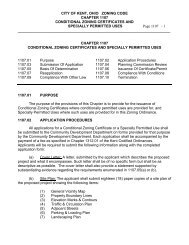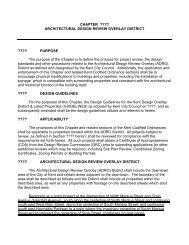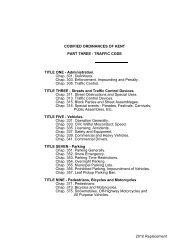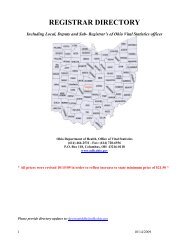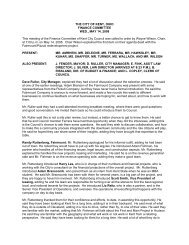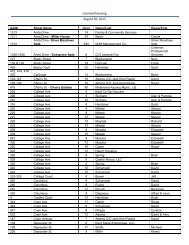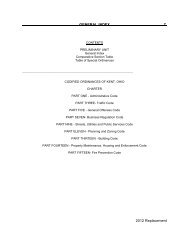1 ZONING CODE APPENDIX B SIGN DESIGN ... - City of Kent
1 ZONING CODE APPENDIX B SIGN DESIGN ... - City of Kent
1 ZONING CODE APPENDIX B SIGN DESIGN ... - City of Kent
Create successful ePaper yourself
Turn your PDF publications into a flip-book with our unique Google optimized e-Paper software.
CITY OF KENT, OHIO <strong>ZONING</strong> <strong>CODE</strong><strong>APPENDIX</strong> B <strong>SIGN</strong> DE<strong>SIGN</strong> GUIDELINES APP B - 3There are no limitations on the types <strong>of</strong> materials used for groundmounted signs or pole mounted signs as long as the materialscompliment the building and site on which the signage is located, aswell as those on adjacent properties.Compatibility:Sign materials should be compatible with the design <strong>of</strong> thebuilding face on which they are located. Materials should notdetract from the legibility <strong>of</strong> the sign. For example, glossyfinishes may be difficult to read in high glare situations.Sign LegibilitySigns should effectively communicate the message for which they are intended. Legibility<strong>of</strong> the content <strong>of</strong> a sign is <strong>of</strong> extreme importance.Letter Sizing:Letter sizing should be determined by the nature <strong>of</strong> the signand its intended audience. Pedestrian oriented signage, whichis typically viewed at shorter distances, should have smallerlettering, generally ranging in size from 3” to 6”. Signage whichis to be viewed from the highway should be sized based on thedistance from the highway and the legally traveled speed onthe highway. Permit applicants should justify the size <strong>of</strong> theirsignage and its lettering based on these concepts.The Architectural Review Board and/or the CommunityDevelopment Department may request documentation from thesign permit applicant regarding the size <strong>of</strong> a sign and itslettering and may refuse to grant an approval for such signagewhere the letter size cannot be justified.Messaging:Spacing:Symbols / Logos:The message being conveyed on a sign should be as brief andclearly stated as possible. Fewer words are generally moreeffective in communication and in legibility. Sign designersshould consider the content carefully to determine what isminimally necessary to convey the advertising message.Letters and words should not be spaced too closely since thecrowding <strong>of</strong> letters will make a sign more difficult to read.Conversely, letters should not be over-spaced to the pointwhere the reader has to read each letter individually. Unlessotherwise limited in Chapter 1165 <strong>of</strong> this zoning code, letteringshould not occupy more than 75% <strong>of</strong> the sign panel area.Symbols and logos may be used on a sign to convey a
CITY OF KENT, OHIO <strong>ZONING</strong> <strong>CODE</strong><strong>APPENDIX</strong> B <strong>SIGN</strong> DE<strong>SIGN</strong> GUIDELINES APP B - 4message as long as the size and nature <strong>of</strong> the symbol / logocompliments the overall size and design <strong>of</strong> the sign.Font Styles:It is generally recommended that the number <strong>of</strong> font styles belimited to the smallest number needed. Font styles that aredifficult to read (including intricate type faces and/or cursive)are discouraged, especially on highway oriented signage.Sign IlluminationSign illumination should be carefully considered when planning any sign. The illuminationmethod can compliment a sign’s message or compromise its effectiveness. Improperillumination can also cause a hazard to public safety.Necessity:Energy Use:The sign designer / user should consider the necessity <strong>of</strong>providing additional lighting to illuminate the sign. Signage onwindows may benefit from internal building lighting and may notneed additional lighting. Exterior signs may benefit fromambient street lighting as a source <strong>of</strong> illumination.Sign lighting should use timing mechanisms wherever possibleto reduce the consumption <strong>of</strong> power. If possible, sign lightingshould be turned <strong>of</strong>f when the business is closed or duringearly morning hours between 1:00 AM and 6:00 AM whenvehicular and pedestrian traffic is limited.Source:Signs may be internally lit or directly lit by spotlights so long assuch lighting does not shine brightly <strong>of</strong>f-site on private or publicproperty. Direct lighting will <strong>of</strong>ten highlight a sign in relation tothe building architecture and compliment the architecturalfeatures. Such lighting should be the minimum necessary toadequately illuminate the sign. Direct light sources should beshielded to prevent glare and light pollution onto adjoiningresidential properties. The <strong>City</strong> may require a photometriclighting plan as part <strong>of</strong> a sign permit or Comprehensive SignPlan application.



